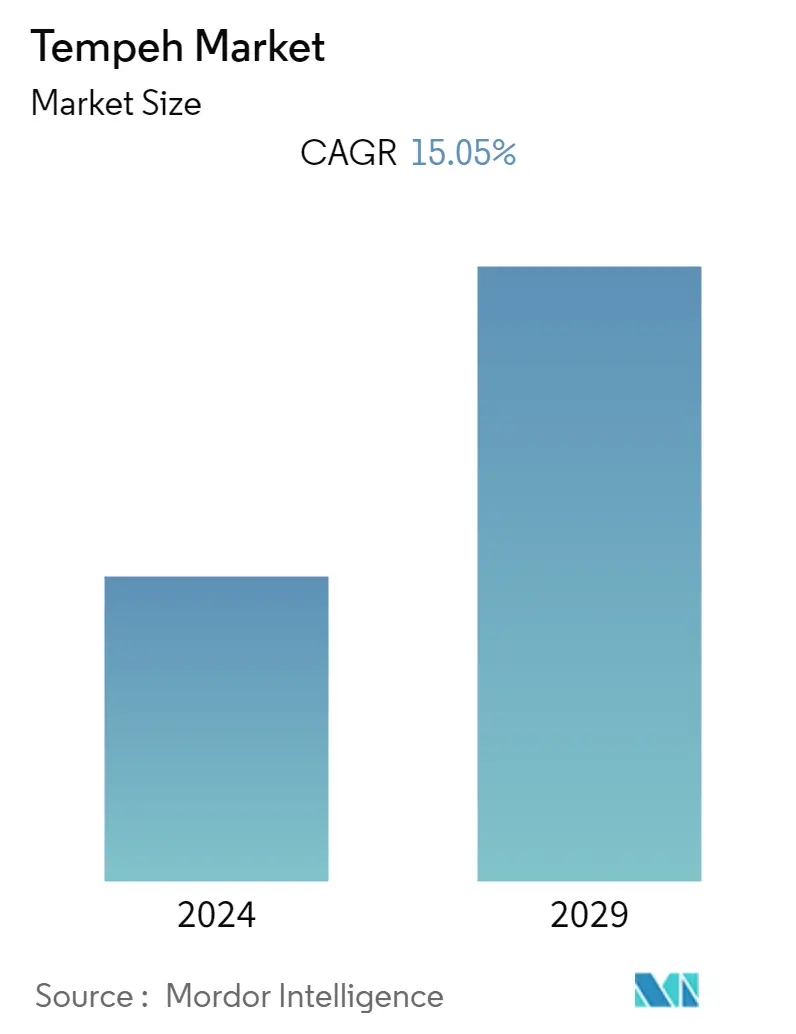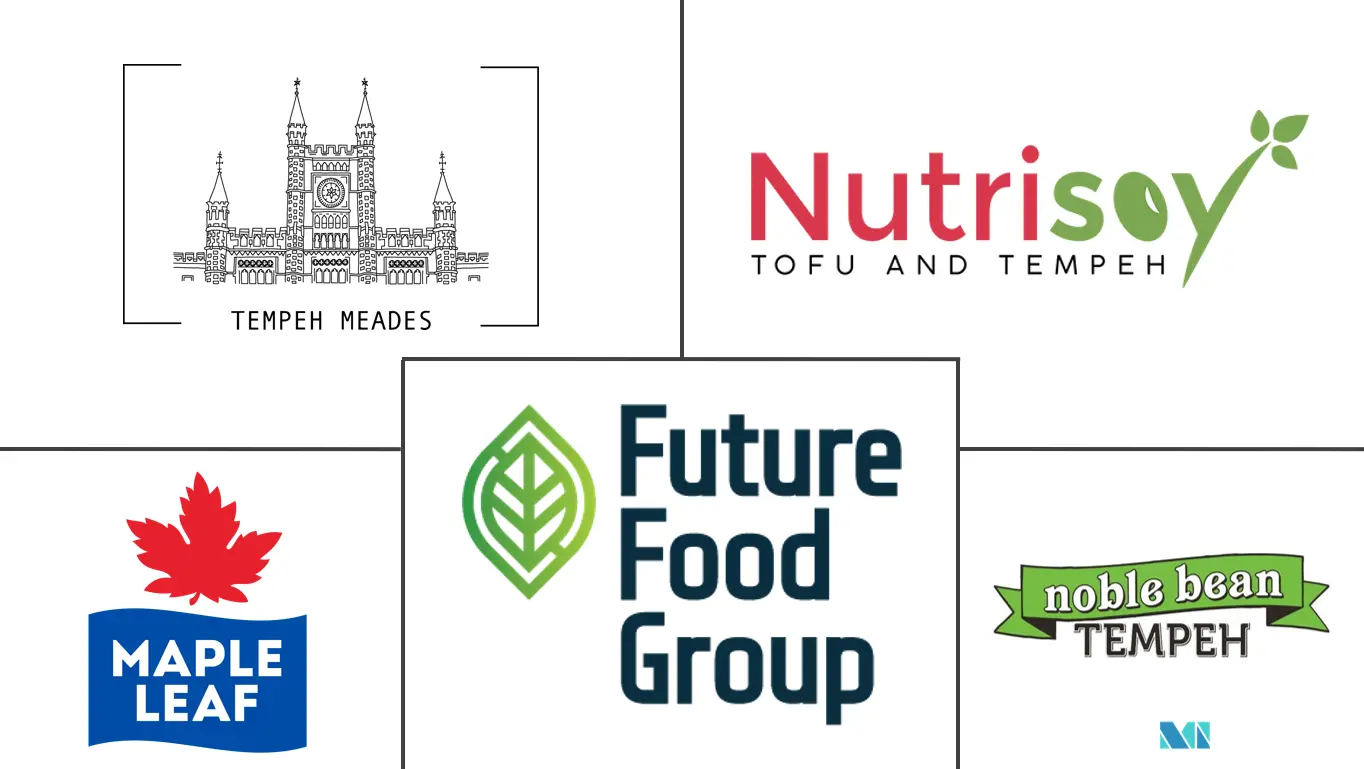Market Size of Tempeh Industry

| Study Period | 2019 - 2029 |
| Base Year For Estimation | 2023 |
| CAGR | 15.05 % |
| Fastest Growing Market | Asia-Pacific |
| Largest Market | North America |
| Market Concentration | Low |
Major Players
*Disclaimer: Major Players sorted in no particular order |
Tempeh Market Analysis
The Tempeh market is expected to register a CAGR of 15.05% during the forecast period.
With an increasing vegan population on the market, the demand for meat substitutes such as plant-based meat products has increased significantly in recent years. Tempeh is one of the most commonly consumed plant-based meats on the market. Tempeh is a nutrient-dense, versatile food that is becoming well-liked across the world with the increasing consumption of plant-based foods as tempeh is a nutritional mealtime option. Additionally, with increasing flexibility among the consumers in the market, However, the major challenge in this sector is the presence of a large number of competing products in the market, such as tofu, textured vegetable protein (TVP), seitan, and Quorn.
Additionally, in recent years, the growing concern about animal abuse for meat production has had a valuable impact on the way consumers think about meat consumption. This factor further changes the consumer's consumption choice towards plant-based meat products to reduce animal slaughtering for meat and thereby increase the demand for meat analogs in the market. Furthermore, various organizations consider slaughtering an ethical issue. According to Animal Clock, as of 2022, more than 55 billion land and sea animals will be slaughtered annually to support the food supply in countries like the United States.
Tempeh Industry Segmentation
Tempeh is a meat alternative that is high in protein and has a meat-like texture. It is made by fermenting soybeans with a live culture. The global tempeh market has been segmented by type, distribution channel, and geography. By type, the market is segmented into organic and regular. Based on distribution channels, the market is segmented into hypermarkets and supermarkets, convenience stores, online retail stores, and other distribution channels. The report covers the geographical analysis of major and developing economies in the world, covering North America, Europe, Asia-Pacific, South America, and the Middle East and Africa. For each segment, the market sizing and forecasts have been done on the basis of value (in USD million).
| Type | |
| Organic | |
| Regular |
| Distribution Channel | |
| Hypermarket/Supermarket | |
| Convenience Stores | |
| Online Retail Stores | |
| Other Distribution Channels |
| Geography | |||||||||
| |||||||||
| |||||||||
| |||||||||
| |||||||||
|
Tempeh Market Size Summary
The tempeh market is experiencing significant growth, driven by the rising demand for plant-based meat substitutes among an increasingly vegan population. Tempeh, known for its nutritional benefits and versatility, is gaining popularity globally as a preferred plant-based protein source. This shift in consumer preference is largely influenced by growing concerns over animal welfare and the ethical implications of meat production. As consumers become more health-conscious, the demand for vegetarian and vegan foods, including tempeh, is on the rise, supported by increased awareness of the health benefits associated with soy products. Innovations in tempeh products, such as odorless variants, are further propelling market growth, with promotional efforts and government investments in plant-based food initiatives enhancing consumer adoption.
The Asia-Pacific region, particularly countries like China, Indonesia, and South Korea, is witnessing robust growth in the tempeh market due to its cost-effectiveness and health benefits, such as cholesterol reduction and diabetes risk mitigation. Despite the high demand, the region faces challenges in soybean production, leading to significant imports from the United States. The global tempeh market is highly competitive, with numerous domestic and multinational companies vying for market share. Key players are focusing on product innovation and strategic partnerships to expand their presence and cater to diverse consumer needs, particularly in the snacking segment. Recent product launches in markets like India and the United States highlight the ongoing efforts to introduce tempeh products with local flavors and convenience, further driving market expansion.
Tempeh Market Size - Table of Contents
-
1. MARKET DYNAMICS
-
1.1 Market Drivers
-
1.2 Market Restraints
-
1.3 Porter's Five Forces Analysis
-
1.3.1 Threat of New Entrants
-
1.3.2 Bargaining Power of Buyers/Consumers
-
1.3.3 Bargaining Power of Suppliers
-
1.3.4 Threat of Substitute Products
-
1.3.5 Intensity of Competitive Rivalry
-
-
-
2. MARKET SEGMENTATION
-
2.1 Type
-
2.1.1 Organic
-
2.1.2 Regular
-
-
2.2 Distribution Channel
-
2.2.1 Hypermarket/Supermarket
-
2.2.2 Convenience Stores
-
2.2.3 Online Retail Stores
-
2.2.4 Other Distribution Channels
-
-
2.3 Geography
-
2.3.1 North America
-
2.3.1.1 United States
-
2.3.1.2 Canada
-
2.3.1.3 Mexico
-
2.3.1.4 Rest of North America
-
-
2.3.2 Europe
-
2.3.2.1 Spain
-
2.3.2.2 United Kingdom
-
2.3.2.3 Germany
-
2.3.2.4 France
-
2.3.2.5 Italy
-
2.3.2.6 Russia
-
2.3.2.7 Rest of Europe
-
-
2.3.3 Asia-Pacific
-
2.3.3.1 China
-
2.3.3.2 Japan
-
2.3.3.3 India
-
2.3.3.4 Australia
-
2.3.3.5 Rest of Asia-Pacific
-
-
2.3.4 South America
-
2.3.4.1 Brazil
-
2.3.4.2 Argentina
-
2.3.4.3 Rest of South America
-
-
2.3.5 Middle-East and Africa
-
2.3.5.1 South Africa
-
2.3.5.2 United Arab Emirates
-
2.3.5.3 Rest of Middle-East and Africa
-
-
-
Tempeh Market Size FAQs
What is the current Tempeh Market size?
The Tempeh Market is projected to register a CAGR of 15.05% during the forecast period (2024-2029)
Who are the key players in Tempeh Market?
Tempeh Meades Ltd, Maple Leaf Foods Inc., Future Food Group (FFG B.V), Nutrisoy Pty Ltd and Noble Bean Inc are the major companies operating in the Tempeh Market.

